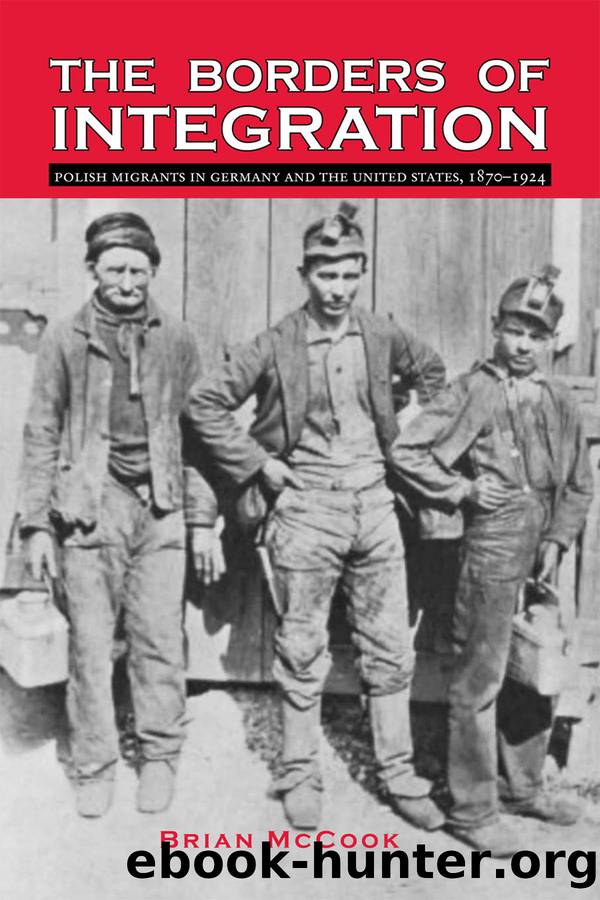The Borders of Integration by McCook Brian;

Author:McCook, Brian;
Language: eng
Format: epub
Publisher: Ohio University Press
Published: 2011-08-15T00:00:00+00:00
Polish Organizational Responses and Their Influence on Integration
Poles in the Ruhr and northeastern Pennsylvania confronted enormous challenges in gaining acceptance. The belief was widespread that this ethnic minority posed a threat to the security and health of the nation. Prussian officials sought a solution to its Polish question in the Ruhr by impinging on the civil rights of Poles, despite the fact that they were legal citizens, in the misguided belief that enough use of the proverbial stick would force Poles to eventually eat the carrot of Verschmelzung, or outright assimilation. Local, state, and federal governments in the United States interfered little in the day-to-day affairs of Poles, though starting in the 1890s a growing consensus emerged that Poles, on moral and racial grounds, were unfit to become Americans. Attempts were subsequently made to limit their presence and ability to become citizens. Such anti-immigrant attitudes reflected the panic over Polish immigration within the German and American public imagination. Though there were dissenters who argued that Poles could become good citizens and assets to the nation, this view increasingly was in the minority, especially in Germany.
In response to the efforts to exclude and discriminate against them, Poles focused on network building through ethnic associations to defend their rights. The types of ethnic associations varied widely, reflecting the diversity of immigrants. Some were religious, others secular. Some were right-wing and ethnically exclusive, others more inclusive and left-leaning. All were nationalist and committed to preserving Polish culture and identity. Regardless of orientation, Polish ethnic associations went far in helping Poles build their communities and promote their structural integration in their adopted societies. This can be seen in Germany, where despite attempts to impose restrictions on their activity, associations actively mobilized their members to participate in and achieve success in elections, use the courts to defend their rights, and become visible in the public sphere. In the United States, associations provided many Poles with an important degree of economic security not otherwise available to them. They aided Polish political mobilization at the local and national level. Exposing Polish immigrants to American political practices, associations also helped Poles challenge public perceptions that they were âun-Americanâ through activities such as organizing civic education efforts linking Polish and American ideals and values. Perhaps the best illustration of the role of associations in promoting integration occurred in the development of womenâs associations, where women could build their own networks within patriarchal societies, promote their ethnic and gender interests, and begin practicing democracy at a time when they did not possess the vote.
Polish associations in northeastern Pennsylvania diverged from those in the Ruhr in three key respects. First, many in northeastern Pennsylvania were also mutual-aid (insurance) societies, which served important economic as well as political and cultural functions in the life of migrants. In the Ruhr, associations generally did not play as large an economic role because of the existence of state and employer-sponsored welfare programs. Second, Polish associations in northeastern Pennsylvania were more varied across the political spectrum, whereas in the Ruhr, right-leaning associations tended to predominate.
Download
This site does not store any files on its server. We only index and link to content provided by other sites. Please contact the content providers to delete copyright contents if any and email us, we'll remove relevant links or contents immediately.
| Africa | Americas |
| Arctic & Antarctica | Asia |
| Australia & Oceania | Europe |
| Middle East | Russia |
| United States | World |
| Ancient Civilizations | Military |
| Historical Study & Educational Resources |
Cat's cradle by Kurt Vonnegut(14760)
Pimp by Iceberg Slim(13779)
Underground: A Human History of the Worlds Beneath Our Feet by Will Hunt(11839)
4 3 2 1: A Novel by Paul Auster(11792)
The Radium Girls by Kate Moore(11621)
Wiseguy by Nicholas Pileggi(5318)
American History Stories, Volume III (Yesterday's Classics) by Pratt Mara L(5136)
Perfect Rhythm by Jae(5072)
The Fire Next Time by James Baldwin(5017)
Paper Towns by Green John(4800)
Pale Blue Dot by Carl Sagan(4618)
A Higher Loyalty: Truth, Lies, and Leadership by James Comey(4551)
The Mayflower and the Pilgrims' New World by Nathaniel Philbrick(4281)
The Doomsday Machine by Daniel Ellsberg(4246)
Killers of the Flower Moon: The Osage Murders and the Birth of the FBI by David Grann(4189)
Too Much and Not the Mood by Durga Chew-Bose(4095)
The Sympathizer by Viet Thanh Nguyen(4095)
The Borden Murders by Sarah Miller(4019)
Sticky Fingers by Joe Hagan(3912)
